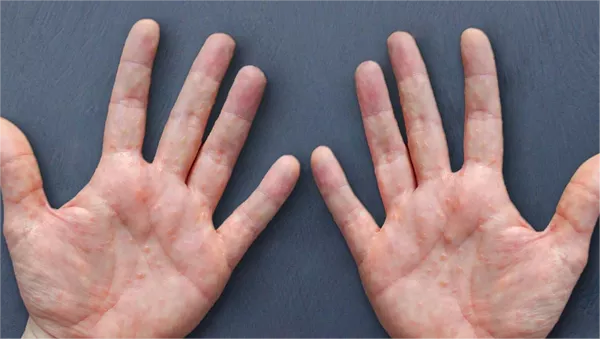Dyshidrotic eczema, also known as pompholyx eczema or dyshidrosis, is a perplexing skin disorder characterized by the development of small, itchy blisters on the hands and feet. These blisters, often accompanied by redness, swelling, and intense itching, can be debilitating and significantly impact an individual’s quality of life. While the exact cause of dyshidrotic eczema remains elusive, researchers have identified several triggers that may exacerbate or precipitate its onset. In this comprehensive article, we delve into the various factors that contribute to the development and aggravation of dyshidrotic eczema, shedding light on this enigmatic dermatological condition.
Understanding Dyshidrotic Eczema: A Brief Overview
Before delving into the triggers of dyshidrotic eczema, it is essential to grasp the fundamental aspects of this dermatological ailment. Dyshidrotic eczema primarily affects the palms of the hands, the sides of the fingers, and the soles of the feet, although it can occasionally manifest on other parts of the body. The condition is characterized by the formation of small, fluid-filled blisters, often accompanied by itching, redness, and a burning sensation. These blisters may cluster together, causing discomfort and pain, and may eventually burst, leading to the formation of raw, weeping patches of skin.
Despite being a relatively common condition, dyshidrotic eczema poses numerous challenges to both patients and healthcare providers due to its unpredictable nature and the lack of a definitive cure. While the exact pathogenesis of dyshidrotic eczema remains unclear, various triggers have been identified, which can exacerbate symptoms and precipitate flare-ups in susceptible individuals.
Identifying Triggers: Unraveling the Factors Behind Dyshidrotic Eczema Flare-Ups
1. Allergens and Irritants:
Allergic reactions to certain substances and exposure to irritants can play a significant role in triggering dyshidrotic eczema flare-ups. Common allergens and irritants include:
- Nickel: Found in jewelry, watches, and metal tools, nickel is a potent allergen known to trigger eczematous reactions in sensitive individuals.
- Chemicals: Contact with harsh detergents, solvents, soaps, and cleaning agents can irritate the skin and exacerbate dyshidrotic eczema symptoms.
- Rubber: Rubber gloves, footwear, and other rubber-containing products may contain accelerators and additives that can trigger allergic reactions in susceptible individuals.
2. Stress and Emotional Factors:
Psychological stress and emotional factors have long been implicated in the exacerbation of various dermatological conditions, including dyshidrotic eczema. Stress triggers the release of certain hormones and neuropeptides that can disrupt the skin’s barrier function, increase inflammation, and exacerbate eczematous symptoms.
3. Weather Conditions:
Changes in weather and environmental factors can significantly impact the severity of dyshidrotic eczema symptoms. Exposure to extremes of temperature, humidity, and sunlight can trigger flare-ups in some individuals, while others may experience exacerbations during the colder, drier months of the year.
4. Dietary Factors:
Although the role of diet in dyshidrotic eczema remains controversial, some individuals may find that certain foods exacerbate their symptoms. Common dietary triggers include:
- Dairy products
- Gluten-containing foods
- Citrus fruits
- Spicy foods
- Processed foods
Elimination diets and keeping a food diary can help identify specific dietary triggers and alleviate symptoms in susceptible individuals.
5. Microbial Infections:
Bacterial, fungal, and viral infections can contribute to the development and exacerbation of dyshidrotic eczema. Staphylococcus aureus, in particular, has been implicated in the pathogenesis of eczema, with colonization of the skin leading to inflammation and the release of toxins that trigger flare-ups.
6. Hormonal Changes:
Hormonal fluctuations, such as those occurring during pregnancy, menstruation, or menopause, can influence the onset and severity of dyshidrotic eczema. Changes in hormone levels can affect the skin’s barrier function, immune response, and inflammatory pathways, predisposing individuals to flare-ups during certain phases of their reproductive cycle.
7. Occupational Exposures:
Occupational exposure to certain substances and environmental conditions can increase the risk of developing dyshidrotic eczema. Jobs that involve frequent handwashing, exposure to chemicals, or prolonged contact with water may predispose individuals to develop eczematous reactions on the hands and fingers.
8. Genetic Predisposition:
Genetic factors play a significant role in the susceptibility to dyshidrotic eczema. Individuals with a family history of eczema, asthma, or allergic rhinitis are more likely to develop the condition, suggesting a genetic predisposition to atopic dermatitis and related allergic disorders.
Managing Dyshidrotic Eczema: Strategies for Prevention and Treatment
Effective management of dyshidrotic eczema involves identifying and avoiding triggers, implementing appropriate skincare practices, and utilizing pharmacological and non-pharmacological treatments to alleviate symptoms and prevent flare-ups. Key strategies for managing dyshidrotic eczema include:
1. Avoiding known triggers: Identifying and avoiding allergens, irritants, and other triggers can help minimize the risk of flare-ups and alleviate symptoms.
2. Maintaining proper skincare: Practicing good hand and foot hygiene, moisturizing regularly, and using gentle, fragrance-free skincare products can help maintain the skin’s barrier function and prevent dryness and irritation.
3. Managing stress: Stress management techniques, such as mindfulness, meditation, and deep breathing exercises, can help reduce psychological stress and prevent stress-induced flare-ups.
4. Using topical treatments: Topical corticosteroids, calcineurin inhibitors, and emollients are commonly used to reduce inflammation, itching, and blister formation in dyshidrotic eczema.
5. Phototherapy: Phototherapy, or light therapy, involves exposing the affected skin to ultraviolet (UV) light under controlled conditions to reduce inflammation and improve symptoms.
6. Oral medications: In severe cases of dyshidrotic eczema, oral medications such as corticosteroids, immunosuppressants, or antihistamines may be prescribed to control symptoms and prevent flare-ups.
Conclusion
Dyshidrotic eczema is a complex and multifactorial skin condition characterized by the development of small, itchy blisters on the hands and feet. While the exact cause of dyshidrotic eczema remains unknown, various triggers have been identified, including allergens, irritants, stress, weather conditions, dietary factors, microbial infections, hormonal changes, occupational exposures, and genetic predisposition. By understanding and avoiding these triggers and implementing appropriate management strategies, individuals with dyshidrotic eczema can effectively control their symptoms and improve their quality of life. Further research into the pathogenesis and treatment of dyshidrotic eczema is warranted to develop more targeted and effective therapeutic interventions for this challenging dermatological condition.
























